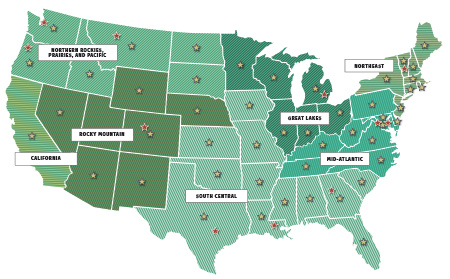Disease is a normal part of the natural world. Most ecosystems include viruses, bacteria, fungi, and parasites that cause disease. Healthy wildlife and ecosystems have evolved defenses to fend off most diseases before they have devastating impacts. An ecosystem with lots of variation (genetic diversity and diversity of species) is more resilient to the impacts of disease because there are greater possibilities that some species have evolved resistance, or if a species is lost, there will likely be another species to fill the niche of an extinct species.
Where ecosystems are not healthy, due to a loss in biodiversity and threats such as habitat loss, climate change, pollution, or invasive species, wildlife and ecosystems are more vulnerable to emerging diseases. Diseases caused by or carried by invasive species are particularly threatening, as native wildlife may have no natural immunity to them.
Chytrid Fungus: Batrachochytrium dendrobatidis (or “chytrid” for short), is a fungus that grows on the skin of amphibians, interfering with their ability to breathe or take up water through their skin. It has spread across the globe, infecting and decimating frog populations. It's a global killer of amphibians.
Fibropapillomatosis: Sea turtles worldwide are becoming infected with this disease, possibly caused by viruses, which causes tumors to appear on the skin or internally. These tumors can make it difficult for a turtle to swim, eat, or see, and they weaken immune systems.
White-Nose Syndrome: Hundreds of thousands of bats in the Northeast and mid-Atlantic states have been infected or have died from the white-nose fungus. The disease affects hibernating bats, making them appear to have a white substance on their faces and wings.
Chronic Wasting Disease: This disease is a highly contagious, fatal neurological disease (spongiform encephalopathy) primarily infecting deer and elk. The disease is believed to be caused by a modified protein called a prion.
Whirling Disease: Trout, salmon, and whitefish in 25 states have been infected by the parasite Myxobolus cerebralis that causes whirling disease. It damages nerves and cartilage, causing young fish to die and older fish to swim in a tail-chasing or whirling motion, making it hard for them to find food and increasing their vulnerability to predators.
Sylvatic Plague: Prairie dogs are highly susceptible to this bacterial disease, which is transmitted by fleas. The endangered black-footed ferret is at even greater risk from the effects of the disease, because not only can it be infected by the disease, but prairie dogs are also its primary food source.
Wildlife and human health are closely intertwined, as illustrated by the COVID-19 pandemic and the SARS epidemic. We're seeing more wildlife diseases traveling quickly around the planet. As people increase their contact with wildlife, their habitat, and domestic animals, it's more and more likely diseases will be transmitted between people and wildlife. We need to maintain healthy ecosystems to reduce the risk of wildlife disease for our own health and for the future of America’s wildlife.
But the natural world is not only a source of diseases; it is also the source of potential cures. Every year we discover more about how to treat disease from compounds we find in nature. We need to safeguard biodiversity to preserve all of the potentially useful compounds that nature is constantly inventing.
A new storymap connects the dots between extreme weather and climate change and illustrates the harm these disasters inflict on communities and wildlife.
Learn MoreTake the Clean Earth Challenge and help make the planet a happier, healthier place.
Learn MoreA groundbreaking bipartisan bill aims to address the looming wildlife crisis before it's too late, while creating sorely needed jobs.
Read MoreMore than one-third of U.S. fish and wildlife species are at risk of extinction in the coming decades. We're on the ground in seven regions across the country, collaborating with 52 state and territory affiliates to reverse the crisis and ensure wildlife thrive.
